Dealing with a landlord dispute or eviction can be stressful—but understanding your rights under Texas law can make all the difference. Many renters believe a lease is an ironclad contract, locking them in no matter the circumstances. Fortunately, Texas law provides specific protections for tenants, establishing legally valid reasons to break a lease without facing severe financial penalties.
Feeling trapped in a rental agreement that no longer serves your needs or, worse, threatens your safety, is a difficult position. Whether you are an active-duty service member receiving deployment orders, a victim of domestic violence needing to relocate, or a tenant living in a property with serious, unaddressed repair issues, you have legal recourse. The key is knowing which situations qualify, what the Texas Property Code requires, and exactly what steps to take to protect yourself.
This guide is designed to empower you with that knowledge. We will explore eight legally recognized reasons to terminate your lease early, from uninhabitable living conditions and landlord harassment to military service and illegal lease clauses. For each reason, we'll explain the specific Texas Property Code sections that apply, provide clear, step-by-step instructions for giving proper notice, and outline the documentation you’ll need to protect your rights. This article will provide the actionable information you need to confidently navigate your situation and make the best decision for your future.
1. Habitability Violations (Uninhabitable Conditions)
Every lease in Texas comes with a powerful, unspoken promise from your landlord known as the "implied warranty of habitability." This legal principle guarantees that your rental property is safe and livable. When a landlord fails to maintain this standard, it is not just an inconvenience; it can be one of the most valid reasons to break a lease.
Under Texas Property Code § 92.052, your landlord has a legal duty to repair any condition that "materially affects the physical health or safety of an ordinary tenant." If you have properly notified your landlord of such an issue and they have failed to make repairs in a reasonable time, you may have grounds to terminate your lease agreement. This right is fundamental because it goes to the core of your rental agreement: paying for a safe place to live.
What the Texas Property Code Says About Habitability
Not every annoyance qualifies. The issue must be serious enough to impact your well-being. A real-world scenario might involve a broken air conditioner during a sweltering Texas summer. If you notify your landlord in writing and they ignore the request for weeks, the intense heat could affect your physical health, creating a valid habitability violation.
Common examples include:
- No Hot Water: Lack of hot water is a clear violation.
- HVAC Failures: A failed heater in winter or a broken AC unit in summer.
- Serious Leaks or Flooding: A constantly leaking roof that causes water damage and creates electrical hazards is a major safety concern.
- Severe Pest Infestations: An uncontrollable infestation of rats, cockroaches, or other pests that the landlord fails to address.
- Structural and Safety Hazards: This includes broken locks, faulty wiring, or significant mold growth. Among the most critical habitability violations are issues that pose immediate health risks, such as severe sewage damage, which can render a property completely uninhabitable.
How to Legally Break a Lease for Uninhabitable Conditions
You cannot simply pack up and leave. To legally break your lease for habitability reasons, you must follow this step-by-step process:
- Provide Written Notice: You must give your landlord written notice of the needed repair, preferably via certified mail with a return receipt requested. This creates an undeniable legal record that they received your request.
- Ensure Your Rent is Current: You must be up-to-date on your rent payments at the time you give notice. Withholding rent can jeopardize your legal standing and tenant rights.
- Allow a Reasonable Time for Repair: The landlord must be given a reasonable amount of time to fix the issue after receiving your notice.
- Send a Second Notice (Termination Notice): If the repair is not made, you must send a second written notice stating that due to their failure to repair, you are terminating the lease.
Understanding these legal steps is essential to protect your rights. For a deeper dive into this topic, you can learn more about what a Texas tenant's rights are.
2. Active Military Deployment (Military Clause Exception)
Military service often involves sudden and non-negotiable changes. Recognizing this, both federal and state laws provide special protections for service members who need to break a lease due to their military obligations. This protection allows active-duty military personnel to terminate their residential leases without facing the steep penalties that typically apply to early termination.
Under the federal Servicemembers Civil Relief Act (SCRA), a service member can legally terminate a lease if they receive military orders for a permanent change of station (PCS) or to deploy with a military unit for 90 days or more. This federal law overrides any conflicting lease provision, offering a powerful and clear-cut reason to break a lease that landlords must honor. This ensures that military personnel can focus on their duty without the added stress of a binding civilian contract.
Who is Covered by the SCRA?
This protection extends to various service members who receive qualifying orders.
- Real-World Scenario: Imagine a soldier at Fort Hood receives orders to deploy to Europe for six months. They can legally terminate their Killeen apartment lease by providing their landlord with written notice and a copy of their orders.
Examples of covered individuals include:
- Active-Duty Service Members of the Army, Navy, Air Force, Marine Corps, or Coast Guard.
- Activated Reservists called to active duty for more than 90 days.
- National Guard Members called to federal active duty for more than 90 days.
- Commissioned Corps Members of the Public Health Service or the National Oceanic and Atmospheric Administration.
How to Legally Terminate a Lease for Military Duty
While your right to terminate is strong, you must follow the correct steps to use it legally.
- Provide Written Notice: You must deliver a written notice of termination to your landlord or their agent. This notice should clearly state your intention to terminate the lease under the SCRA.
- Include a Copy of Your Orders: Along with the written notice, you must provide a copy of your military orders. This is the crucial evidence that proves your eligibility to terminate the lease.
- Timing is Key: The termination becomes effective 30 days after the first date on which the next rental payment is due. For example, if you give notice on August 15th and your rent is due on the first of the month, your lease will terminate on September 30th.
Understanding your rights under the SCRA is vital for a smooth transition. If you are a service member facing a lease issue, exploring your options with a Texas landlord-tenant lawyer can provide clarity and ensure your rights are protected.
3. Illegal Entry or Privacy Violations
When you sign a lease, you are paying for the exclusive right to use and enjoy your rental property. This fundamental right, often called the "covenant of quiet enjoyment," means your landlord cannot enter your home whenever they please. Landlord entry is governed by specific rules, and repeated violations can be a valid reason to break a lease.
Under Texas Property Code § 92.0081, a landlord may not enter your home unless authorized by the lease agreement. Most standard Texas leases require the landlord to provide advance notice, typically 24 hours, before entering for non-emergency reasons like inspections, repairs, or showings. Constant, unannounced intrusions disrupt your peace and can be considered a breach of the lease, potentially giving you grounds for termination.
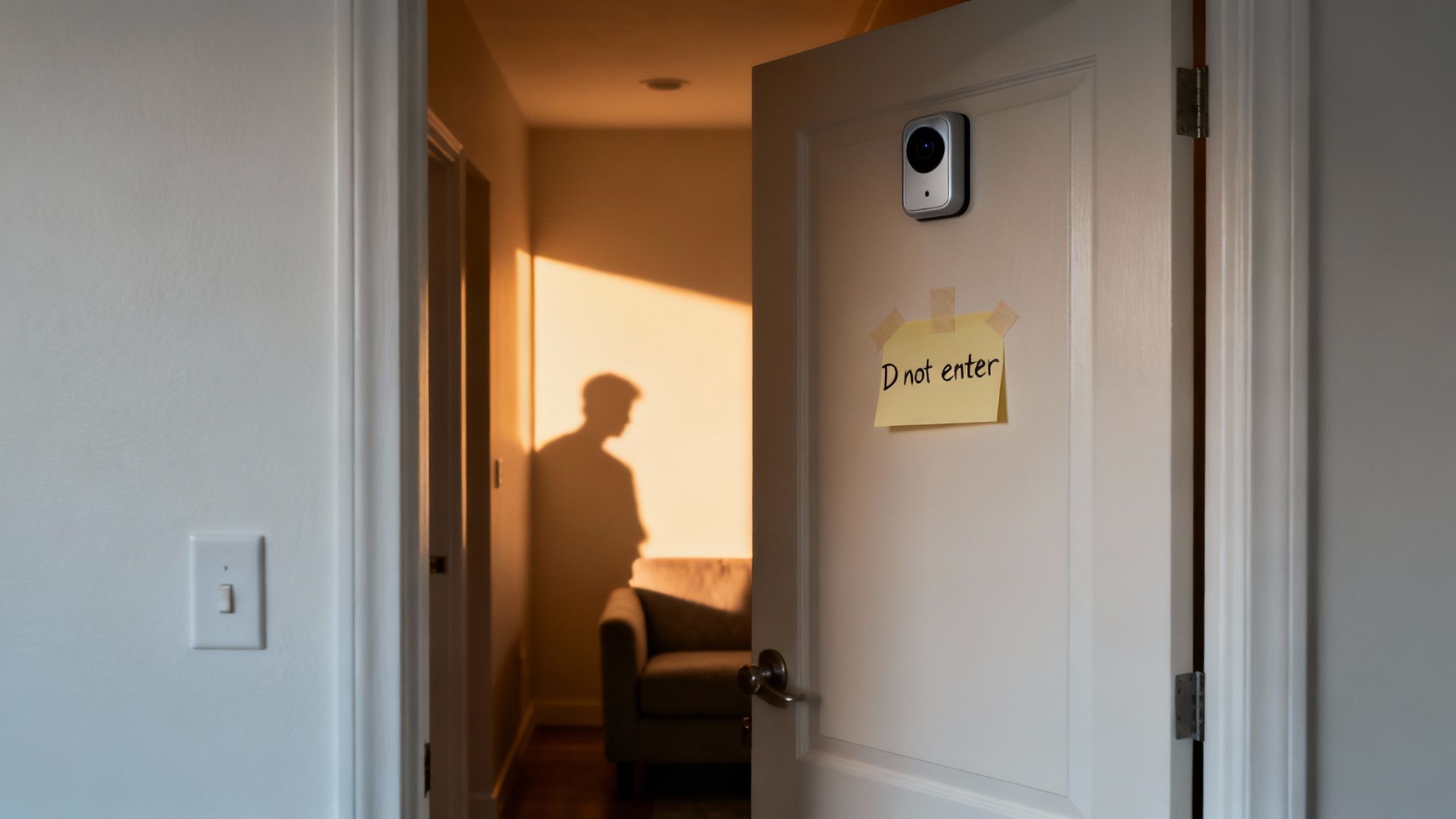
What Qualifies as a Privacy Violation?
Not every entry is illegal. Emergencies, such as a fire or major flood, allow a landlord to enter immediately. However, repeated non-emergency entries without proper notice can qualify as a serious violation.
- Real-World Scenario: Your landlord shows up unannounced multiple times to show your apartment to prospective renters, despite your lease requiring 24-hour notice. After you send a written demand for them to stop, they do it again. This pattern could be grounds for lease termination.
Common examples include:
- Routine Unannounced Visits: The landlord or their agent frequently shows up and lets themselves in without prior notice or your consent.
- Excessive Showings: Scheduling an unreasonable number of showings that disrupt your daily life.
- Removing Doors or Windows: A landlord cannot remove your front door or windows to force you out.
- Harassment: Using their access rights to harass or intimidate you.
- Improper Surveillance: Installing cameras inside your private living space without explicit consent.
How to Address Illegal Entry
You cannot just change the locks. To legally terminate your lease due to illegal entries, you must document the behavior and follow a clear, step-by-step process.
- Review Your Lease: First, carefully read the entry clause in your lease agreement. It will specify the notice requirements your landlord must follow.
- Document Every Incident: Keep a detailed log of every unauthorized entry. Note the date, time, and any witnesses.
- Provide Written Notice: Send a formal letter via certified mail to your landlord. In the letter, state the specific violations of your lease's entry clause and demand that the behavior stop immediately. This creates a crucial paper trail.
- Send a Termination Notice: If the landlord continues to violate your privacy after receiving the written warning, you may have grounds to terminate. You would then send a second notice stating your intent to terminate the lease due to their continued breach.
If you are facing a landlord who repeatedly enters your home without permission, understanding your legal options is the first step. For more guidance, learn about the steps to take when a landlord is harassing you.
4. Domestic Violence or Victim Safety Exceptions
Your personal safety is paramount, and Texas law recognizes that tenants who are victims of family violence, sexual assault, or stalking need a way to escape dangerous living situations without penalty. This legal protection allows eligible tenants to terminate their lease early, offering a critical lifeline for those needing to relocate to ensure their safety.

Under Texas Property Code § 92.016, you may terminate a lease early if you are a victim of family violence or certain sexual offenses. This statute acknowledges that forcing a victim to remain in a home where their abuser knows their location can be life-threatening. This provision is one of the most important reasons to break a lease because it prioritizes your physical safety over the financial obligations of a rental contract.
What Qualifies for This Protection?
To use this right, you must have specific documentation proving your status as a victim. You cannot terminate the lease simply by stating you feel unsafe. You must provide the landlord with a copy of one of the following:
- A Protective Order: Issued under Chapter 85 of the Texas Family Code.
- A Temporary Injunction: Issued after a court hearing.
- A Temporary Ex Parte Order: Issued under the Texas Family Code.
- Documentation of sexual assault or stalking: Under Section 92.0161, you can also provide documentation from a licensed healthcare provider or victim advocate to terminate a lease.
Step-by-Step Guide for Lease Termination
You must follow a precise legal path to protect yourself from liability for future rent.
- Obtain Proper Documentation: You must secure one of the court orders or other qualifying documents listed above. This is the foundational requirement.
- Provide Written Notice of Termination: You must give your landlord a written notice of your intent to terminate the lease. The notice must specify the date you will vacate, which is typically 30 days after the notice is given.
- Provide a Copy of the Order: Along with your written notice, you must give the landlord a copy of your protective order or other required documentation.
- Vacate the Property: You must move out of the rental property on or before the date specified in your termination notice.
Once these steps are completed, your lease is terminated, and you are not responsible for any future rent payments. Understanding your rights in these situations is critical. For more information, you can explore the protections of a Texas Protective Order.
5. Landlord Harassment or Constructive Eviction
While a lease is a binding contract, it's also a two-way street. You have a right to "quiet enjoyment" of your home, meaning you can live peacefully without significant disturbances from your landlord. When a landlord's actions become so severe that they make the property unlivable, it can legally be considered a "constructive eviction," providing you with a valid reason to break a lease.
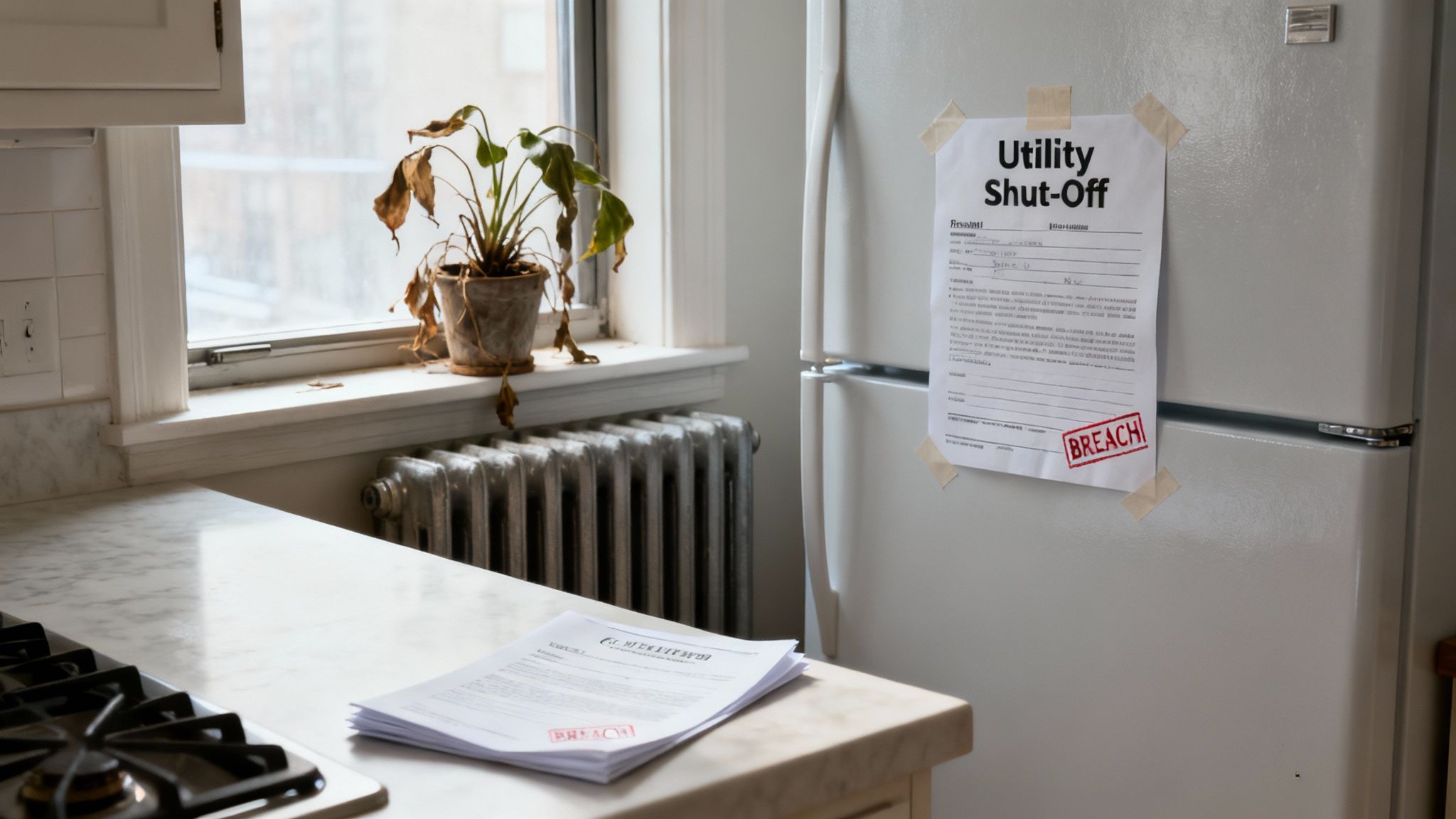
Constructive eviction occurs when a landlord, through their actions or deliberate inaction, essentially forces you out. This legal concept treats the landlord's behavior as a breach of the lease, releasing you from your obligation to pay rent. Under Texas Property Code § 91.001, lease agreements imply a covenant of quiet enjoyment, and intentional acts that violate this can have serious consequences for a landlord. An experienced eviction attorney can help you navigate this complex issue.
What the Texas Property Code Says About Harassment
This goes far beyond minor annoyances. The behavior must be persistent and substantially interfere with your ability to live in your home.
- Real-World Scenario: Your landlord is angry about your repair requests and decides to shut off your water for two days to "teach you a lesson." This intentional act makes the property unlivable and could be considered constructive eviction.
Common examples include:
- Illegal Entry: The landlord repeatedly entering your home without proper notice, violating your privacy.
- Utility Shut-Off: Intentionally shutting off essential services like water, electricity, or heat to force you out.
- Refusing Essential Repairs: Willfully failing to perform critical repairs that make the property unsafe.
- Intimidation and Threats: Engaging in threatening behavior or verbal abuse.
- Changing the Locks: Illegally locking you out of your own rental unit without a court order.
How to Document and Resolve Landlord Harassment
You cannot just declare "constructive eviction" and move out. Proving it requires a clear and well-documented trail of evidence.
- Document Every Incident: Keep a detailed log of every instance of harassment. Note the date, time, what happened, and any witnesses.
- Provide Written Notice: Send the landlord a formal, written notice via certified mail. The letter should describe the harassing behavior and demand that it stops immediately.
- Gather Evidence: Collect any evidence you can, such as photos, videos, or statements from witnesses. If threats are made, consider filing a police report.
- Move Out and Terminate: If the harassment continues after notice, making the property unlivable, you must actually vacate the premises to complete the constructive eviction claim.
To better understand what constitutes illegal actions by a landlord, you can get more information on the specifics of landlord harassment in Texas.
6. Landlord or Tenant Bankruptcy
When either a landlord or a tenant files for bankruptcy, it can create significant uncertainty and may provide a complex pathway for terminating the lease. This situation is one of the more legally intricate reasons to break a lease, as it involves federal bankruptcy law intersecting with Texas property law.
When a landlord files for bankruptcy, the lease becomes an asset of the bankruptcy estate. A court-appointed trustee takes control of the landlord's assets. Under Section 365 of the U.S. Bankruptcy Code, the trustee can either "assume" (continue) or "reject" (terminate) existing leases. If the trustee rejects your lease, you have the right to treat the lease as terminated and move out.
How Bankruptcy Affects a Lease
The outcome often depends on the type of bankruptcy filed. A Chapter 7 liquidation often leads to the sale of the property, where a trustee might reject leases to make the property more attractive to buyers. A Chapter 11 reorganization might see the landlord try to keep the leases to maintain income.
- Real-World Scenario: The owner of your apartment complex files for Chapter 7 bankruptcy. To liquidate assets quickly, the trustee formally rejects all existing tenant leases, giving you a legal basis to terminate your obligations and move.
Steps to Take if Your Landlord Files Bankruptcy
Because this process is governed by federal bankruptcy court, it is highly procedural.
- Stay Informed: Once a bankruptcy is filed, you should receive an official notice. Monitor the case and look for any motions filed by the trustee regarding your lease.
- Continue Paying Rent: Unless a court order or the trustee explicitly instructs you otherwise, you must continue to pay your rent. The lease remains in effect until it is formally rejected.
- Document Everything: Keep detailed records of all communications from the landlord, their attorney, or the bankruptcy trustee.
- Consult an Attorney: Bankruptcy law is complex. If your landlord files for bankruptcy, it is critical to consult with a Texas landlord tenant lawyer who understands how to protect your rights.
7. Illegal or Unenforceable Lease Terms
A lease is a binding contract, but its power is limited by state and federal law. If your lease agreement contains clauses that are illegal, discriminatory, or fundamentally unfair, the entire contract may be considered void. This means you may have a valid reason to break a lease without facing the typical financial penalties.
Under Texas law, certain rights cannot be waived in a lease. For example, Texas Property Code § 92.006 prohibits lease provisions that waive a landlord’s duty to repair conditions affecting tenant health and safety. A landlord cannot force you to sign away your fundamental rights as a tenant.
What Makes a Lease Term Illegal?
Not all unfavorable clauses are illegal. The term must violate a specific law or public policy.
- Real-World Scenario: Your lease includes a clause stating that the landlord can enter your apartment at any time without notice for any reason. This directly contradicts your right to quiet enjoyment and Texas notice laws, making it unenforceable.
Common examples include:
- Discriminatory Clauses: A "no children" policy in a standard apartment complex violates the Fair Housing Act.
- Waiver of Essential Rights: A clause stating the tenant is responsible for all repairs, including major structural ones.
- Unconscionable Penalties: A provision imposing extreme and unreasonable fees for minor infractions.
- Illegal Entry Provisions: A clause giving the landlord the right to enter your apartment at any time without notice.
How to Address an Illegal Lease Clause
You cannot just declare the lease void and move out. Using an illegal clause to terminate your agreement requires a careful and documented approach.
- Identify the Specific Clause: Pinpoint the exact language in your lease that you believe is illegal.
- Research the Relevant Law: Find the specific Texas Property Code section or federal law that the clause violates. Legal guidance is often necessary here.
- Provide Written Notice to the Landlord: Send a formal letter via certified mail to your landlord. The letter should identify the illegal clause, cite the law it violates, and state your intention to terminate the lease as a result.
- Prepare for a Dispute: The landlord may disagree. Be prepared to defend your position, which may involve negotiation or, in some cases, a court declaration from a judge.
8. Violation of Lease Agreement by Landlord (Material Breach)
Beyond habitability, your lease is a contract filled with specific promises from your landlord. If your landlord fails to deliver on a significant promise written into the lease, this is known as a "material breach" and can be a legitimate reason to break a lease.
This situation differs from a habitability violation because it relates to specific, contracted amenities or services rather than fundamental safety. Under Texas law, a lease is a contract, and when one party fails to uphold their end of the bargain in a major way, the other party may be excused from their obligations. This provides tenants with powerful reasons to break a lease when they are not receiving what they are paying for.
What Qualifies as a Material Breach?
The key word is "material," meaning the breach must be significant, not a minor inconvenience. It must substantially deprive you of a benefit promised in the lease.
- Real-World Scenario: You rented an apartment specifically because the complex advertised a 24/7 fitness center and a secure, gated parking garage. A month into your lease, the landlord permanently closes the gym and leaves the parking gate broken and open. This failure to provide promised amenities could be a material breach.
Examples include:
- Promised Amenities: A landlord permanently closing a community gym or pool that was included as an amenity in your lease.
- Loss of Essential Services: The lease guarantees assigned parking or 24/7 security, but the landlord discontinues these services.
- Failure to Provide Utilities: The lease states that the landlord will pay for water, but they stop paying the bill, leading to a service cutoff.
Step-by-Step Process for a Material Breach
Similar to other lease termination reasons, you must follow a strict legal process to protect yourself.
- Review Your Lease: Carefully read your lease and identify the exact clause the landlord has violated.
- Provide Written Notice: Send your landlord a formal written notice via certified mail. The notice should clearly state which part of the lease has been breached and demand they fix the issue (a "notice to cure").
- Allow a Reasonable Time to Remedy: The landlord must be given a reasonable opportunity to correct the breach.
- Document Everything: Keep copies of your lease, all written correspondence with your landlord, and photos or videos that prove the breach.
If the landlord fails to remedy the situation after proper notice, you may have grounds to terminate the lease. You can find more information about how to handle a landlord breach of lease on texastenantlawyers.com.
8-Point Comparison: Reasons to Break a Lease
| Option | Implementation complexity 🔄 | Resource requirements ⚡ | Expected outcomes ⭐📊 | Ideal use cases 💡 | Key advantages ⭐ |
|---|---|---|---|---|---|
| Habitability Violations (Uninhabitable Conditions) | Moderate 🔄 — requires notice & thorough documentation | Medium ⚡ — photos, written notice, possible tenant advocacy or attorney | High ⭐⭐⭐ 📊 — likely lease release, repairs, or rent remedies when documented | Loss of heat/water, severe mold, pest infestations, structural hazards | Strong legal precedent; safety prioritized; common ground for termination |
| Active Military Deployment (Military Clause Exception) | Low 🔄 — statutory process under SCRA | Low ⚡ — official orders + written notice; military legal assistance available | Very high ⭐⭐⭐⭐ 📊 — nationwide lease termination without penalty for qualifying orders | Active-duty deployment or PCS for servicemembers | Federal protection (SCRA); straightforward and widely enforceable |
| Illegal Entry or Privacy Violations | Moderate 🔄 — must show repeated or systematic breaches | Low–Medium ⚡ — logs, timestamps, cameras, written complaints | Medium–High ⭐⭐📊 — termination and damages possible if violations are proven | Repeated unauthorized entries, hidden cameras, surveillance | Protects tenant privacy; can support counterclaims and damages |
| Domestic Violence or Victim Safety Exceptions | Low–Moderate 🔄 — jurisdiction-specific but often expedited | Low ⚡ — police reports, court orders, or certified documentation; advocacy support | High ⭐⭐⭐ 📊 — rapid termination and anti-retaliation protections common | Immediate relocation for safety after assault, threats, or stalking | Prioritizes safety; rapid relief and legal anti-retaliation protections |
| Landlord Harassment / Constructive Eviction | High 🔄 — must prove deliberate, ongoing interference | Medium–High ⚡ — incident logs, witnesses, police reports, legal counsel | Medium–High ⭐⭐📊 — termination and damages possible but proof-intensive | Persistent threats, harassment, intentional utility shutoffs, intimidation | Remedies for abusive conduct; can combine with other claims for relief |
| Landlord or Tenant Bankruptcy | Very high 🔄 — complex interaction with federal bankruptcy law | High ⚡ — monitoring filings, bankruptcy counsel, potential court involvement | Variable ⭐ 📊 — outcome depends on trustee decisions and bankruptcy chapter | Landlord files Chapter 7/11 or foreclosure affecting tenancy | May allow lease rejection/termination; protects tenants from unstable ownership |
| Illegal or Unenforceable Lease Terms | Moderate 🔄 — requires legal analysis of lease provisions | Medium ⚡ — legal research, housing authority or attorney consultation | High ⭐⭐⭐ 📊 — illegal clauses are void; termination or amendment likely | Discriminatory clauses, illegal waivers, terms violating local codes | Strong legal defense; courts typically refuse to enforce illegal terms |
| Violation of Lease Agreement by Landlord (Material Breach) | Moderate–High 🔄 — must establish materiality and follow cure process | Medium ⚡ — signed lease, written notices, documentation, possible litigation | Medium–High ⭐⭐📊 — termination possible if breach is material and uncured | Removal of promised amenities/services or failure to perform lease obligations | Contract-based remedy; enforces explicit lease promises |
Navigating Your Lease Termination? You Don't Have to Do It Alone.
Terminating a lease agreement before its end date is a significant decision with both potential freedom and considerable risk. As we've detailed, Texas law provides specific, legally protected reasons to break a lease, but doing so successfully requires more than just a valid justification. It demands a meticulous approach grounded in the Texas Property Code, precise documentation, and strict adherence to procedural timelines.
A misstep can have severe consequences, from losing your security deposit to facing a lawsuit for unpaid rent and damaging your credit. The difference between a clean break and a costly legal battle often lies in the details: the wording of your notice, the evidence you've collected, and your understanding of your specific rights under the law.
Key Takeaways for Protecting Your Rights
To ensure you navigate this process correctly, let's recap the most critical takeaways:
- Documentation is Your Strongest Ally: Your case is only as strong as your evidence. Keep a detailed log of all communication, take time-stamped photos of property conditions, and save copies of all notices.
- Written Notice is Non-Negotiable: Verbal agreements are not legally sufficient. The Texas Property Code almost always requires formal, written notice delivered via certified mail.
- Know the Specific Texas Property Code Section: Your rights are not abstract. Citing the correct statute, like Section 92.056 for repairs or Section 92.016 for domestic violence, demonstrates you are acting on a firm legal foundation.
- Landlord Breaches Must Be "Material": For a landlord's failure to be a valid reason for termination, the breach must be "material." This means it significantly impacts your ability to use the property as intended.
Understanding these principles transforms you from a passive tenant into an empowered advocate for your own rights. Once you've navigated the legalities, the next step is often finding a new place. For a smooth transition, consider consulting a comprehensive resource like this complete moving guide to help manage the logistics.
Ultimately, while the law provides a pathway, the journey can be complex. You don't have to face this challenge alone. Seeking professional legal guidance from a Texas landlord tenant lawyer is a strategic move to protect your financial future and secure your peace of mind.
If you need help with an eviction, lease issue, or rental dispute, contact The Law Office of Bryan Fagan, PLLC for a free consultation today.

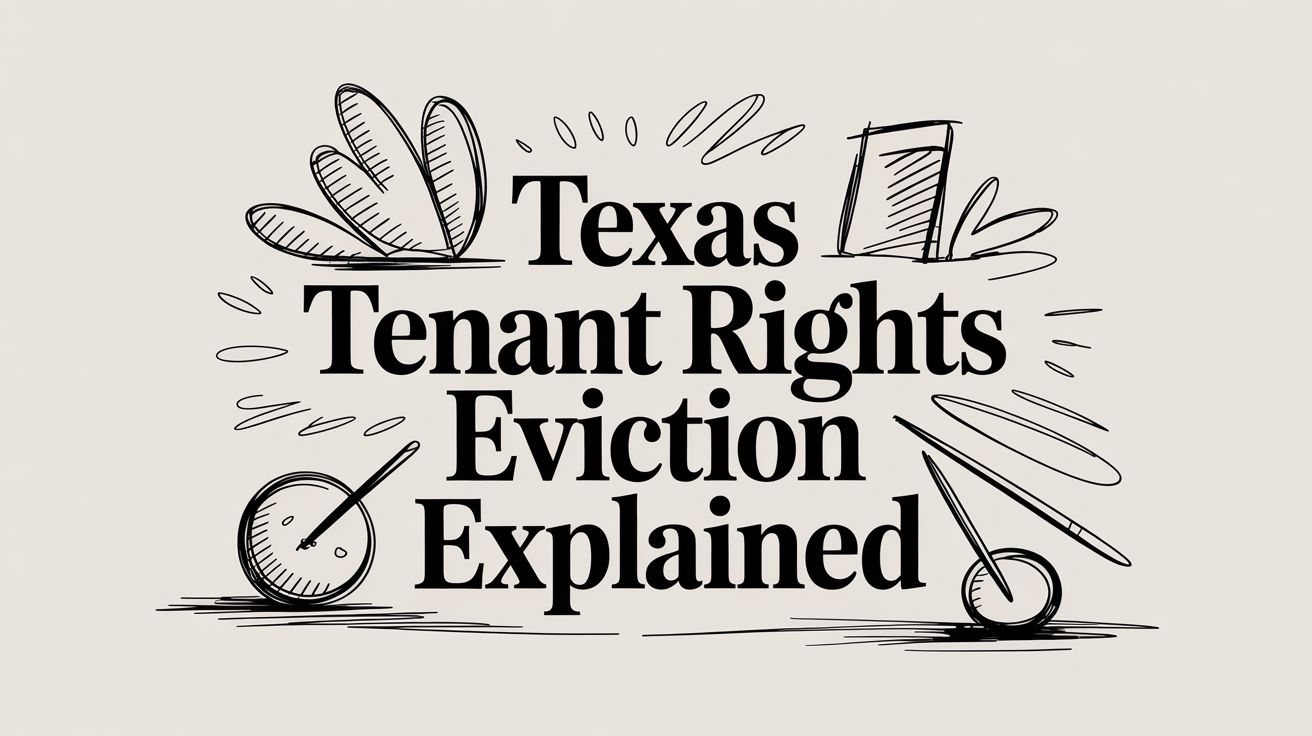
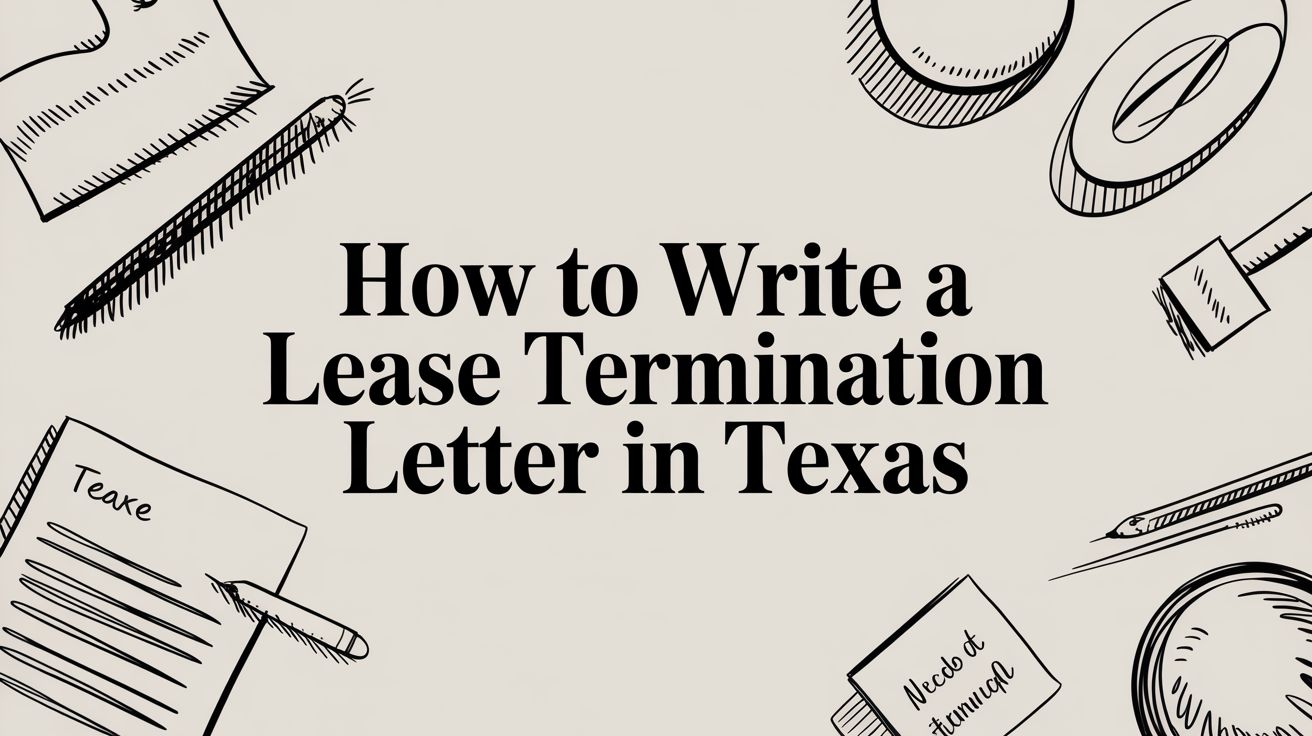

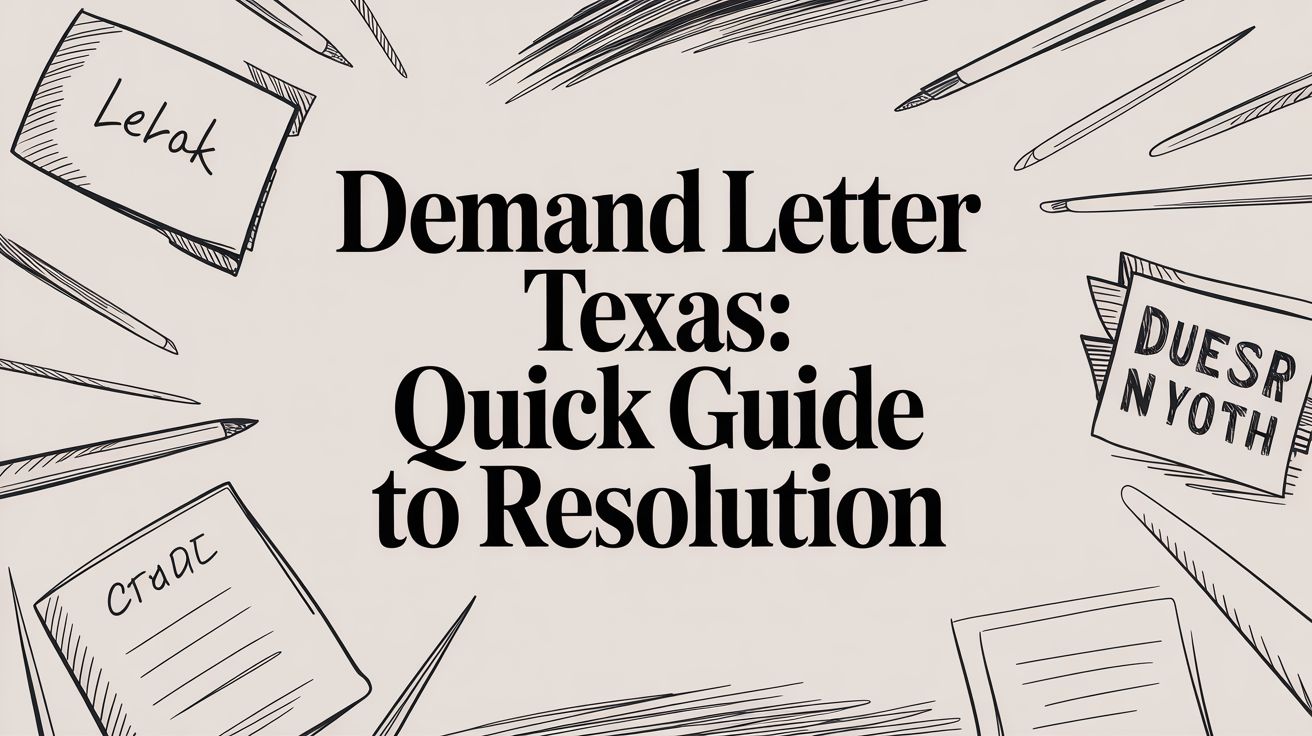
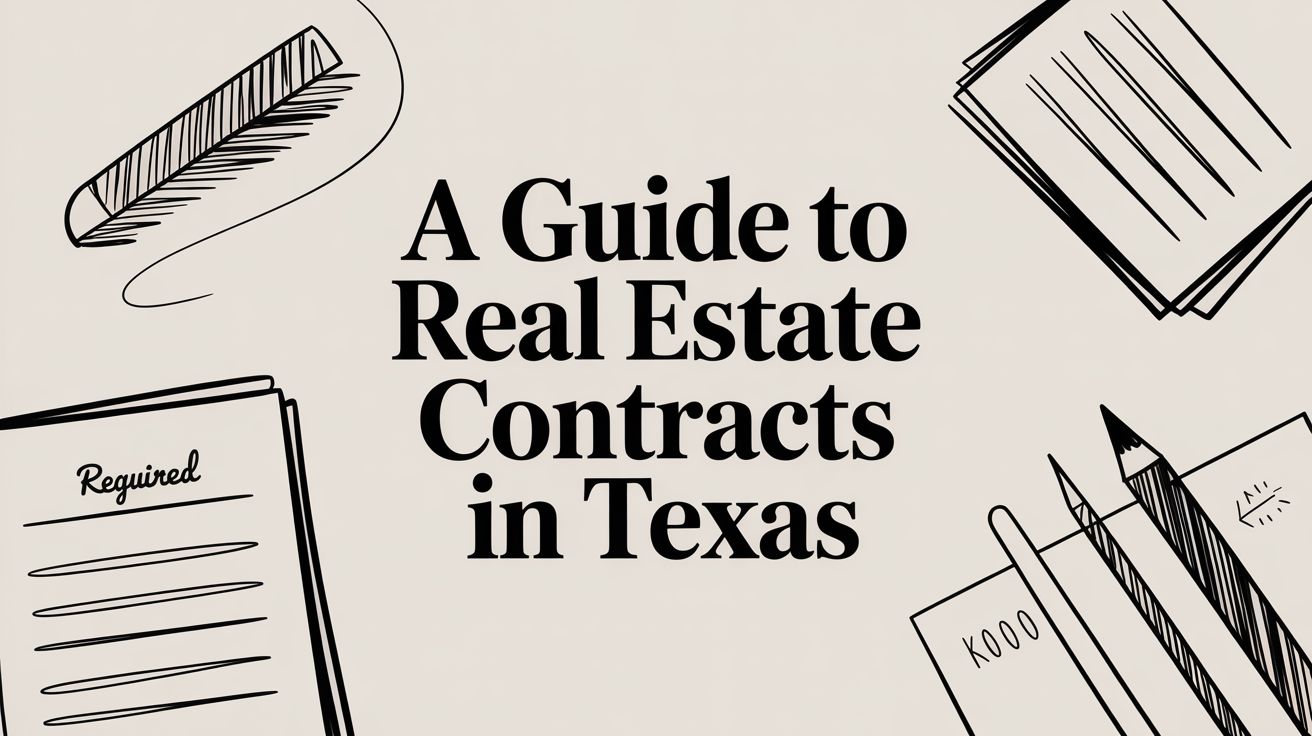
![Graphic design featuring the title "8 Valid Reasons to Break a Lease in Texas [2025 Guide]" with decorative elements like a pen and paper, emphasizing tenant rights and legal guidance in Texas.](https://texastenantlawyers.com/wp-content/uploads/2025/11/featured-image-7ebe2aec-eacb-4e61-8e85-9c298b07ad11.jpg)
